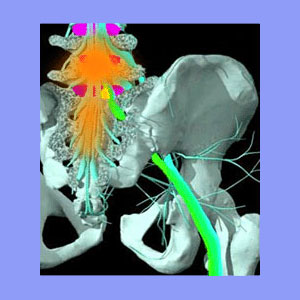
A damaged sciatic nerve can be a dire prognosis for any patient, although I have heard this verdict pronounced many times in error. The sciatic nerve is the main neurological pathway for the entire lower body and injury here can produce widespread and serious consequences. However, this nerve is not easily traumatized and most cases of diagnosed nerve damage in the sciatic structure are either completely incorrect or actually involve damage to the lumbosacral nerve roots which eventually join together to form the sciatic nerve lower in the anatomy.
This essay will document trauma to the sciatic nerve and its various possible consequences.
Damaged Sciatic Nerve Causes
The most common form of actual damage which can occur to the sciatic structure is due to trauma. Car accidents, gunshots, deep lacerations, and near amputations can all injure or even sever the sciatic nerve. These unfortunate events can be repaired in some cases, but may leave permanent effects, as well.
At least when trauma is involved and the path of the nerve can be documented as being cut or damaged, there is no doubt that the diagnostic pronouncement is correct. In cases where nerve damage is suspected from crushing or ongoing compressive muscular issues, the diagnosis may or may not be correct, since diagnostics for these conditions are less accurate.
In many cases, the sciatic nerve suffers decreased functionality not due to direct damage, but because of injury to one or more of the formative spinal nerve roots, which occurs prior to the actual sciatic structure being created.
Sciatic Nerve Injury
A traumatized nerve is a very tricky thing. Sometimes, the patient may experience full function and no lasting effects, despite obvious and documentable damage. Other times, injury may result in temporary or permanent partial or full dysfunction. It is impossible to generalize, except when the nerve is completely severed.
Remember that many diagnosed sciatic nerve damage cases are actually misdiagnosed ischemic syndromes which target the sciatic and surrounding soft tissues. These conditions may also be misidentified as piriformis syndrome or sacroiliac joint concerns in some patients.
The nature of a serious oxygen deprivation condition makes the sciatic nerve lose structural integrity, temporarily producing a signal pattern consistent with nerve damage. However, in these cases, the pattern is completely reversible and does not indicate any injury, despite poor diagnostic theories to the contrary.
Damaged Sciatic Nerve Evidence
Sciatic nerve damage which is theorized to exist without obvious significant and penetrating or crushing injury or spinal trauma is likely to be wrongly identified. The exceptions to this rule occur in people with severe disease conditions which affect the viability of their nerve tissue or conditions which degenerate nerves, such as diabetic neuropathy.
Other exceptions might include patients who have undergone certain surgical procedure which traumatized the nerve directly, or through some resultant process, such as scar tissue or infection.
Never accept this diagnosis blindly and always remember that even documentable nerve functionality reductions can be explained from multiple explanations. If you are truly unfortunate enough to suffer from nerve damage, let’s hope that the future may hold new treatment options. For the rest of you, successful treatment can often be enjoyed right now, once a correct diagnosis is achieved.





